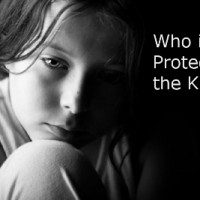The ultimate goal: Keeping families intact
- Details
- Published on Tuesday, 22 April 2014 11:20
- Written by Paul Gordon
Second in a series.
There is no question what the goal of child welfare agencies is when it comes to disposing of child abuse or neglect cases: To keep the family together.
Where there is grey area is with the question of what's in the best interest of the child. And from the start of a case, which is typically a telephone call to law enforcement or the state Department of Children and Family Services, the answer to the question becomes a judgement call.
"We no longer just place children when there is an allegation of abuse. Our primary purpose is child protection and we investigate all claims, but there is always the issue of whether the situation warrants removal of a child from a home. Those are case-by-case decisions for our investigators and caseworkers," said Karen Hawkins, deputy director of communications for DCFS.
"Certainly we are committed to protecting the children. But also, our goal is to keep the family together from the start, if we can. In 1997 there were 55,000 children in foster care and now there are less than 15,000. It isn't because there are fewer reports of abuse or neglect; it's because we are doing what we can to work the case and keeping the child with the family while getting them the help they need. One thing we have learn through the years is that states are not great parents," Hawkins said.
So, what is child abuse or neglect?
DCFS defines it as succinctly as it can in a manual that can be found on its website. The manual is intended for those people who are mandated to report cases or suspicions of abuse, such as teachers, healthcare workers, law enforcement workers and pretty much anybody who works with children on a regular basis.
Physical abuse occurs when a parent or a person responsible for the child's welfare:
• Inflicts, causes to be inflicted, or allows to be inflicted upon such child physical injury, by other than accidental means, which causes death, disfigurement, impairment of physical or emotional health, or loss or impairment of any bodily function.
• Creates a substantial risk of physical injury likely to have the physical impacts listed above. Examples include choking or smothering a child, shaking or throwing a small child, and violently pushing or shoving a child into fixed objects. Other circumstances include incidents of domestic violence in which the child was threatened, violations of orders for the perpetrator to remain apart from the child, and a history of past sexual abuse which may place other children at risk.
• Acts of torture, defined by DCFS as deliberately and/or systematically inflicting cruel or unusual treatment that results in physical or mental suffering.
• Inflicts excessive corporal punishment that leaves bruises on a child, especially a young child.
• Commits or allows to be committed the offense of female genital mutilation.
• Causes illegal drugs to be sold, transferred, distributed, or given to a child under 18 years of age.
The DCFS manual spells out sexual abuse and also discusses the definition of neglect.
"Neglect occurs when a person responsible for the child deprives or fails to provide the child with adequate food, clothing, shelter, or needed medical treatment. Neglect is also alleged when an adult provides inadequate supervision of a child. This can occur when children are left either unsupervised or in the care of someone unable to supervise due to his/her condition.
Also, "a child who is subjected to an environment which is injurious insofar as (i) the child's environment creates a likelihood of harm to the child's health, physical well-being, or welfare and (ii) the likely harm to the child is the result of a blatant disregard of parent or caretaker responsibilities."
Hawkins said sometimes it takes a judgement call to decide how to proceed with a complaint and whether to remove a child or children from the home. "We train very thoroughly on this matter for that reason. There is no substitute for experience," she said.
In its manual, DCFS advises mandatory reporters and investigators to ask themselves the question "Has the child been harmed or been at substantial risk of harm?" This helps focus the issue and moves away from value judgments and attitudes about lifestyles, the agency said.
What causes parents or others to become abusers varies, of course, and research has found much of the problem is cyclical, that abused children grow up to be abusing parents. That isn't always the case, experts quickly point out; but breaking the cycle, they as quickly will add, is difficult to do.
But as far as underlying factors, poverty is the most common denominator, those experts said. It is also, they add, the likely reason there is large disparity in race for the victims of child abuse.
Currently, DCFS statistics show there are 17,117 people, age birth to 21, that are in various stages of being wards of the state because of child abuse or neglect. Of those, 8,793 ̶ or 51.4 percent ̶ are African-American, while 6,835 (39.9 percent) are white and 1,117 (6.5 percent) are Hispanic.
"Poverty is the number one risk factor across all of hell's domain, whether it's child abuse, mental and emotional health issues, substance abuse," said Timothy Drew, a Peoria psychologist who often works with abused children and their families. He was a social worker in the state's foster care system for several years before becoming a psychologist.
Like other child welfare experts, Drew said the chief reason poverty is the top denominator may be partly because those in poverty have to deal more with agencies and people who are mandatory reporters. It also, he added, is because poverty has become multi-generational. "The poverty we see today? We are reaping from the actions people took 100 years ago. That's why there is a disproportionate number of African-American kids in the system," he said.
"I guarantee you child abuse goes on in homes where the parents have six figure incomes. But very few of those come to the attention of child welfare agencies or they have other means of taking care of situations without foster care being involved," Drew said.
"It's important to remember, though, that nobody sets a goal to have their child put in foster care. It happens and it doesn't mean that mother or father doesn't love the child. In 20-plus years of working in the system I have never once felt that a mother didn't love the child," he added.
The three top factors in determining causes of child abuse and neglect, Drew said, are poverty, a family history of disorder, and unreasonable developmental expectations of the child, which could be a parent expecting a small child to be able to do more for themselves than is natural.
Poverty often causes a home environment to be unstable, which can affect a child as much as physical abuse if the parents are unable to care for them well or give them the type of nourishment needed to stay healthy," said Clete Winkelmann, CEO of The Children's Home of Peoria.
"We no longer just treat the child who shows up on our doorsteps. We are reaching deeper into the family to try and find the root causes of the problem. If we can fix that, the better the chances we keep the family intact and the less likely that child ends up back here," he said.
Helping parents to fix their problems, even if it is making sure they know where to get help with food and other basic needs, could go a long way toward breaking the cycle of abuse and neglect, said Pam Perrilles, executive director of CASA (Court Appointed Special Advocate) of Peoria County.
That includes children traumatized by witnessing domestic abuse, she said. "Our first goal is advocating for the child's best interest but also, we do our best to help parents fix the underlying problems," she said.
Martha Herm, executive director of the Center for the Prevention of Abuse, said he facility is best known as a safe haven for women who are victims of domestic violence. But those women usually have children who also need to be protected.
"Very young children who have seen or experienced any type of violence can be very traumatized. That's why we provide counseling to women and children and provide programming for those children. If a parent is being abused, there is a two-thirds likelihood the child is, as well," Herm said.
"Even if they are not, they see it and hear it and it affects them. They sometimes are made out to be the scapegoat. We often have to help them understand that what is going on with their parents is not their fault," she said.
Herm said domestic violence research used to be all about the women. "It took a lot of time and research to figure out that the kids get it, they know about it. They are affected. That's why we no approach the issue from a family-centered standpoint because the violence is not happening in a vacuum. It affects the whole family," she said.
While breaking the cycle of violence and abuse may seem a lofty goal, keeping families together is realistic and improved treatment is helping more families reach that goal every year. In 2013, for example, CASA closed 52 abuse and neglect cases and 45 of them ended with the families being reunited.
Statewide, reunification is up as well, with more than 55 percent of the cases ending on that positive note, said Tricia Fox, CEO of The Center for Youth and Family Solutions.
"It's no longer just about getting the kids through childhood then setting them out on their own," she said. "The goal is to work toward reunification from day one, usually."
She said the state wants each child abuse and neglect case to reach permanency within 18 months of it being opened. Otherwise, children would linger in foster care and the system would be more apt to damage them than help them.
Permanency can mean either family reunification or the child being removed permanently from the abusive home and being adopted. The experts interviewed all agreed there will always be cases that removing a child permanently is in that child's best interest.
Drew said some children possess a resiliency that is more innate than taught and they often are the ones who break the cycle. He described one woman whom he first encountered when she was 16 years old, put into a foster home because her single mother had a drug abuse problem. "Now 20 years later, she has kids of her own. She's a single mother and is at poverty level, but her kids have never been in the system. The big difference is she learned what substance abuse can do and she stayed away from drugs," he said.
Winkelmann said he believes the state and private agencies such as The Children's Home have gotten much better through the years at being able to keep children with their parents without jeopardizing their safety.
"I'm not going to try and say we have a perfect system. Of course it can be better. Are we protecting the kids? Absolutely," he said.
The child welfare field has become more professional and more outcome-driven, which has brought about better case assessments and better methodologies, said Anthony Riordan, chief operating officer of The Center for Youth and Family Solutions. That agency is central Illinois' top agency in dealing with runaways, as well as abuse and neglect victims.
"We used to warehouse kids, just put them in group homes or foster homes while the case went through the juvenile courts. We've gone from that to treating the kids to looking into why these things happen, why they do what they do," he said. "The field is driven by performance-based results, which is the way it should be. Just because you care isn't good enough anymore."
There are success stories in the child welfare field, said Hawkins of DCFS. "It can be when we are able to step in early enough to keep abuse from happening. It can be knowing that a child who survived the abuse and neglect cycle is married with children and a stable home. In fact, we have many DCFS alumni who are now productive members of society and are good parents. Many go into social work themselves. They are an amazing group," she said.
"There is never enough being done for the kids. But we are doing what we can to make sure they are safe."
Tomorrow: We look at a special agency called CASA (Court Appointed Special Advocate), a group of volunteers that are the voice of the children.


















































